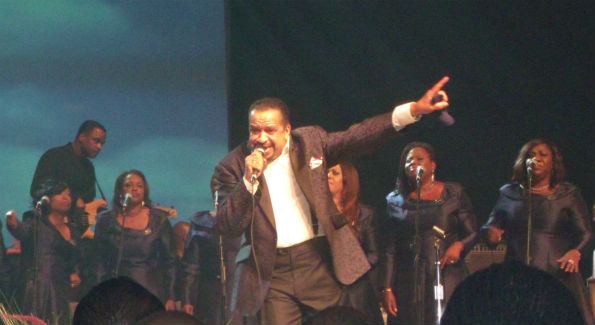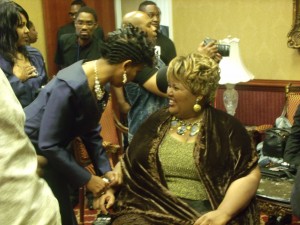Life’s anthology: Live recording captures legendary gospel artist Richard Smallwood’s genius.
By Patrick D. McCoy

Legendary gospel artist and Howard University Alumnus Richard Smallwood and his renowned gospel ensemble Vision recorded his latest project live at Evangel Cathedral before a packed house. (Photo Credit: Patrick D. McCoy)
The word “anthology” describes an expansive collection of work, showing the breadth of an artist’s creative output. Legendary gospel musician Richard Smallwood took to the stage recently, mounting the live recording of his new project “Anthology,” embodying the very word that, for many, expresses the ultimate compilation of his artistic genius. Smallwood’s following goes far beyond his fans. The evening was epic in every sense of the word, from the regally dressed musicians, the audience’s excitement and the breathtaking Gothic cathedral vignettes that set the atmosphere of sacred adoration.

Carolene Adams (seated) received a warm welcome from fellow singers backstage prior to the recording. Adams is the longest-serving consistent member of Smallwood’s ensemble. She has been with him for 33 years. (Photo Credit: Patrick D. McCoy)
Smallwood’s rare combination of natural musical gifts, excellent academic training and personable approach drew supporters locally, nationally and internationally to Evangel Cathedral, just outside of Washington, D.C. for his latest project. He is perhaps one of the few gospel artists that can garner respect from a wide range of figures in the arts. From the college music professor to the young emerging contemporary artist, no one assembled for this latest project could deny the range of artistic diversity represented by those assembled. The legendary Edwin Hawkins, who has been a cornerstone in Smallwood’s career and the gospel music industry, was certainly a standout. Then there were those that represented the generational impact of Smallwood’s influence such as contemporary gospel giants James Hall, Donald Lawrence and Stephen Hurd to emerging artist Anthony Brown of Group Therapy.
His musical contemporary, Darin Atwater, conductor and founder of the renowned Soulful Symphony opened up to Washington Life about Smallwood’s influence on his own career and being a part of the evening’s proceedings. “It’s very nostalgic for me,” he said. “I started my career professionally playing keyboard for Richard back in ’91 for [the recording] ‘Live in D.C.’ at Howard University, so I will never forget it. His music is transcendent, and it runs through so many genres and have impacted so many people worldwide. To be able to galvanize so much of his music in one place at one time is very exciting!”
During the course of the evening, a wide range of musical influences joined harmoniously with the rhythmic drive of gospel music as its back beat. Perhaps the most powerful statement of Smallwood’s ability to marry the textural elements of classical music and gospel was in the majestic “By Faith,” a powerful anthem-like declaration of hope. Toward the end of this statement, sung by Vision, the voices continued to repeat the text “by faith” which for many was a climactic and poignant moment. This is a sterling example of the far-reaching influence that Smallwood’s early musical training at Howard University enabled, encompassing all facets of this musical palette.
Darin Atwater spoke further about this influence. “When I first heard [his] ‘Resurrection’ set to Rachmaninoff’s ‘Vocalise’ it launched me into the possibility of this convergence of classical forms and roots music, including gospel and jazz. I think that has been one of his defining signatures in gospel music, that classical influence. It has allowed us to forge our musicality in different directions other than just gospel music. That is one of his great legacies, this contribution to music.”
Smallwood described the concept of anthology as “going forth, but looking back to visions of the past.” A fascinating aspect was that the new songs actually told the story of the early beginnings through the text. The various medleys performed, such as “The Vision Medley,” were collections of old favorites, yet they were treated with a new flair. Throughout the evening there was a welcomed feeling of nostalgia, from the recollection of past recordings, notable performances and the evolution of The Richard Smallwood Singers to the contemporary group Vision. It was also an evening of surprising facts. Who knew that Smallwood and his singers were perhaps the first gospel choir to sing on a nationally broadcasted soap opera (“Ryan’s Hope”) or to perform in Russia? The evening also included a note on a standout performance in which the great opera soprano Leontyne Price serviced as mistress of ceremonies.
It is almost unfathomable to expect that one evening would be enough to capture Richard Smallwood’s genius and influence. But the outstanding production did a fine job in attempting to do so. From the recollection of his first encounter at Howard University with the talented singer Angela Winbush to his long-standing rapport with his singers such as Carolene Adams, the only singer to be with Smallwood consistently for 33 years. Beautiful slide-show presentations accompanied the evening, providing an in-depth look at Smallwood’s musical evolution.
The evening was a life’s story presented on a grand scale. A collection, a memory: an anthology.
“Anthology: Live” is slated for released 2015
Recently named among the Forty Under 40 for his contributions to arts and humanities, Patrick D. McCoy received a B.M. in vocal performance from Virginia State University and a M.M. in church music from the Shenandoah Conservatory in Winchester, Va. , where he serves on the alumni board of directors. He has contributed arts and culture pieces to CBS Washington, The Afro-American Newspaper and the newly published book, “In Spite of the Drawbacks” (Association of Black Women Historians), which includes his chapter on legendary soprano Leontyne Price. McCoy has interviewed some of the most acclaimed artists of our time, including Renée Fleming, Joshua Bell, Martina Arroyo, Denyce Graves, Eric Owens, Norman Scribner, Julian Wachner, Christine Brewer and Lawrence Brownlee. He is music director at Trinity Episcopal Church, DC. Listen to these interviews and others at Blog Talk Radio. Additionally, he is a member of the Music Critics Association of North America. McCoy may be reached via email at wlperformingarts@aol.com and on Twitter @PatrickDMcCoy.
